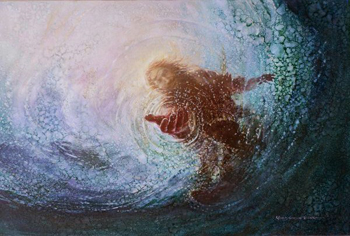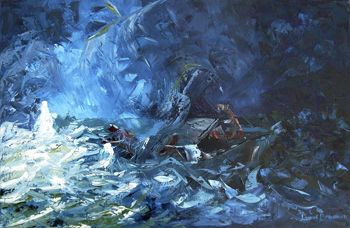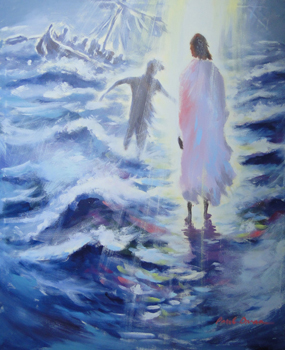For Sunday August 9, 2020
Lectionary Readings (Revised Common Lectionary, Year A)
1 Kings 19:9-18
Psalm 85:8-13
Romans 10:5-15
Matthew 14:22-23
Like some of you, I grew up with “Fear not!” Christianity. A Christianity of Brave Fronts and Happily Ever Afters that left little room for the open acknowledgement of fear. If you're not familiar with this brand of religion, I’ll give you a quick primer. It sounds like this:
"Fear Not" appears in the Bible more often than any other imperative. It’s a commandment. This means that when we fear, we sin.
"Perfect love casts out fear." If you're afraid, then you’re not rooted in God’s love.
"For God has not given us the spirit of fear; but of power, and of love, and of a sound mind." Fear is an aberration. An unsoundness of mind. A brokenness devoid of God.
You can’t be fearful and faithful at the same time. Fear is a clear sign that you lack faith.
I wish I were exaggerating, but I'm not; I grew up hearing these "devout" responses to fear all the time. Instead of inspiring courage or trust, they coated my ever-present fears in guilt, shame, and hopelessness.
In our Gospel story this week, the disciples contend with deep, atavistic fear. Fear of the unknown. Fear of suffering. Fear of death. Fear of oblivion. The setting is the Sea of Galilee, a body of water surrounded by hills, and prone to sudden, violent windstorms. It’s nighttime. The disciples are in a boat, crossing the sea on their own, as per Jesus’s instructions. As the night wears on, the wind and waves intensify, and the disciples, still far from land, struggle against the turbulent water. Meanwhile, Jesus, having spent the previous day teaching and feeding the five thousand, is up in the hills, seeking renewal in solitude and prayer.
 |
Sometime before dawn, Jesus descends from the hills, and approaches the boat. When the disciples see him walking on the water towards them, they’re terrified. “It’s a ghost!” they cry.
“Immediately,” Matthew’s Gospel tells us, Jesus identifies himself in an effort to reassure his disciples: “Take courage! It is I. Don’t be afraid.” As far as we know, eleven of the disciples, frozen in fear, say nothing. But Peter — brash, impetuous, over-the-top Peter — proposes a bizarre test to prove the would-be ghost’s identity: “Lord, if it’s you, tell me to come to you on the water.” Jesus says, “Come,” and Peter steps boldly (recklessly?) out of the boat.
For one luminous second — or two, or ten — Peter walks on the water towards Jesus. But then he realizes what he’s doing. He notices the vicious wind, the rising waves, the dark water — and fear overwhelms him. He begins to drown. “Lord, save me!” he cries. “Immediately,” Jesus reaches out his hand, catches Peter, and delivers him to safety.
“You of little faith,” Jesus says to the breathless, sopping Peter, once the worst of the danger is over. “Why did you doubt?” We never hear Peter’s answer, if he manages to offer one. But as soon as he and Jesus climb into the boat, the wind dies down, the sea grows still and calm, and the disciples recognize Jesus for who and what he is. “Truly,” they say in awe, “you are the Son of God.”
On the face of it, this story might appear to reinforce a “Fear Not!” version of Christianity. I’ve certainly heard sermons that declare as much: “See? When Peter exercises bold, fearless faith in Jesus, he is able to do the impossible. His faith empowers him to walk on water — just like Jesus! But as soon as Peter gives in to fear, he nearly drowns.”
 |
To put it mildly, I don’t agree with this reading. To put it less mildly, I think this reading is dangerous. Nowhere in the Gospels are we called to prove our faith (or test God’s character) by taking pointless risks that threaten our lives. Nowhere in the Gospels does Jesus teach us that bad things happen to us because we’re too chicken to earn God’s protective care. Whether we’re talking about respecting the power of the sea during a vicious storm, or heeding expert medical advice during a global pandemic, the same caution applies. Recklessness is not faith. Stupidity is not courage.
Notice carefully the timeline of events as Matthew’s Gospel relates them. When the disciples see Jesus walking on the water, they’re terrified. They don’t recognize him; they think they’re seeing a ghost or a demon. Naturally, they cry out in fear. At that instant (“immediately”) Jesus offers them comfort and reassurance. He tells them exactly who he is. “Take courage! It is I! Don’t be afraid.”
We don’t know if the silent eleven take Jesus at his word. But we know for sure that Peter does not. He sets Jesus an identity test. “Lord, if it’s you...”
Listen carefully. Can you hear the echoes of another famous identity test in Peter’s words? The identity test Jesus faces in the wilderness, forty days after his baptism? “If you are the Son of God…”
What’s at play here is not the morality or immorality of human fear. What’s at play is how we respond to God’s presence when we’re afraid. What’s at play is what we say and think and feel and do when the divine comes to us in guises we don’t recognize.
The disciples are not wrong to be afraid. Of course they’re afraid! They're afraid because they aren't keen on drowning. They’re afraid because gigantic waves in the middle of the night are scary. They’re afraid because they lack the tools with which to process what they’re seeing; human beings don’t have the ability to walk on water.
If we extend the meaning of "drowning" to include all the ways in which we human beings find ourselves in over our heads in this world, then of course we experience fear. Of course we feel afraid as we face Covid-19, and failing economies, and social isolation, and political brokenness. Of course we feel afraid when unhealthy marriages, sick children, unfriendly neighbors, grinding jobs, and financial uncertainty threaten our lives. Of course we feel afraid when our basic biology betrays us into anxiety, panic, and depression.
 |
The issue is not fear; the issue is where fear leads. Notice the first place that Peter’s fear leads him. He has every right to be afraid when his boat pitches in the dark sea; feeling scared in the face of danger is not the problem. The problem is that his fear leads him straight to suspicion and distrust. His fear leads him to test and question Jesus’s identity, instead of taking Jesus’s self-disclosure at face value. “If it’s you, enable me to do the impossible. If it’s you, make magic happen so that I will be dazzled out of all doubt. If it’s you, reorder reality and prove to me that you’re God.”
Needless to say, Peter’s actions in this story cut right through me; I recognize them so well. Like Peter, I fail to recognize Jesus when the going gets rough. When I face fearsome circumstances, my go-to position is not trust; it's suspicion. In my fear, I forget that my relationship with God is multifaceted and complex, and I reduce it to something crassly transactional: “Okay, Jesus, prove that you care about me. I’ll do A, but you had better do B in return.”
Interestingly, Peter’s test fails. Despite his initial boldness, he is not able to prove who Jesus is by walking on water. He fails within seconds. Why? Because Jesus doesn’t calm the sea for Peter’s convenience. Even though Peter steps out of the boat, his circumstances remain wild and turbulent and dangerous. If Peter thinks he can manipulate Jesus into Making Faith Easy, he learns otherwise fast.
To truly trust Jesus is to hold two pictures of God’s kingdom in productive tension. Yes, sometimes Jesus demonstrates his power in miraculous, Technicolor ways. At other times, though, we need to trust that his Incarnation — his quiet, abiding presence in our wild, untamed lives — is sufficient for the circumstances we face. Sometimes, Jesus' power is paradoxical; it comes to us in what looks like vulnerability, like weakness, like strangeness. The wildness of the sea is no proof of God’s absence.
Once Peter is safe in the boat, Jesus asks him the question he can’t answer: “You of little faith, why did you doubt?” I wonder if Jesus asks this question, not because Peter gives way to panic and nearly drowns, but because his doubt compels him to make a foolish request in the first place. I wonder if Jesus’s question means something like this: “Peter, as soon as you saw me, I told you exactly who I was. You heard my voice. I spoke words of assurance and comfort to you. Why didn’t you believe me?”
Maybe, when Jesus asks us why we doubt, what he’s really asking is: why do you doubt me? Why do you not trust that I’ll be honest with you? Why do you doubt that I am with you, for you, in you, and around you? After all this time, why do you still feel a need to test me?
In my mind, the power of this Gospel story doesn’t lie in Peter’s faith, doubt, courage, or fear. Peter’s trajectory — fascinating though it is — is not the point of the reading. Jesus’s trajectory is the point, because unlike Peter’s, it never changes. It is constant, focused, relentless, and uni-directional. From the very beginning of the story, Jesus moves towards his disciples. He moves towards them when they’re struggling at sea. He moves towards them when they decide he’s a menacing ghost. He moves towards them when they’re terrified by his approach. He moves towards them when they’re reckless enough to set him a dare. He moves towards them when they begin to drown. He moves towards them when they ask for help. He moves towards them when they’re shivering and sorry for their rashness. He moves towards them when they realize — for a beautiful, flickering instant — who he is and what he is. He moves towards them when they worship him.
In other words, Jesus never stops moving towards the ones he loves. He never stops crossing the dark water to come to where we are. Neither our fearfulness nor our faithlessness ever alters his steady approach. We are the ones he’s bound for. Our flailing bodies are the ones he pulls out of the water. Ours is the boat he climbs into. It is for us that he calls out across the terrifying waves, again and again and again: “Take courage. It is I. Don’t be afraid.”
Debie Thomas: debie.thomas1@gmail.com
Image credits: (1) Jackson Community Church, Jackson, New Hampshire, USA; (2) Fine Art America; and (3) What's the Good Word?.





